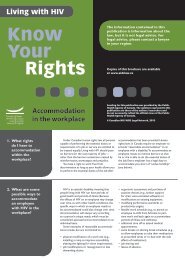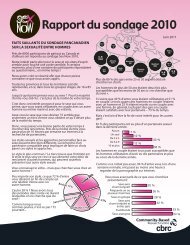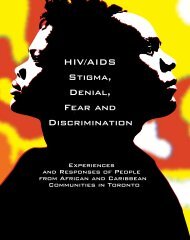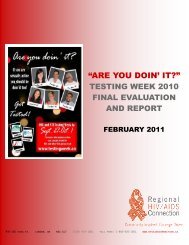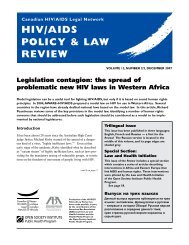FACTSHEET Women and the Biology of HIV Transmission - CATIE
FACTSHEET Women and the Biology of HIV Transmission - CATIE
FACTSHEET Women and the Biology of HIV Transmission - CATIE
You also want an ePaper? Increase the reach of your titles
YUMPU automatically turns print PDFs into web optimized ePapers that Google loves.
<strong>FACTSHEET</strong><strong>Women</strong> <strong>and</strong> <strong>the</strong> <strong>Biology</strong> <strong>of</strong> <strong>HIV</strong> <strong>Transmission</strong>The majority <strong>of</strong> <strong>HIV</strong> infections are transmitted sexually <strong>and</strong> so most <strong>of</strong> <strong>the</strong>transmission occurs through <strong>the</strong> genital or reproductive systems <strong>of</strong> men <strong>and</strong>women. In this fact sheet we review specific biological factors in women thatmake it more or less likely that <strong>HIV</strong> can be sexually transmitted. This is one <strong>of</strong> aseries <strong>of</strong> fact sheets about <strong>the</strong> biology <strong>of</strong> <strong>HIV</strong> transmission.What is <strong>the</strong> female genital tract?The female genital tract is ano<strong>the</strong>r namefor a woman’s reproductive system. Itincludes <strong>the</strong> vagina, cervix, uterus,fallopian tubes <strong>and</strong> ovaries.Many researchers at first thought that<strong>the</strong> chance <strong>of</strong> acquiring <strong>HIV</strong> sexuallythrough <strong>the</strong> female genital tract wasquite low. However, a lot <strong>of</strong> <strong>the</strong> studiesdid not account for various biological <strong>and</strong>social risk factors that can make awoman more susceptible to <strong>HIV</strong>. Thismeans that <strong>the</strong> probability <strong>of</strong> sexuallytransmitting <strong>and</strong> acquiring <strong>HIV</strong> in <strong>the</strong>“real world” may be a lot higher than hasbeen estimated.This fact sheet gives an overview <strong>of</strong> some<strong>of</strong> <strong>the</strong> biological <strong>and</strong> social factors thatare thought to play an important role indetermining a woman’s sexual risk for<strong>HIV</strong> infection or transmission.Researchers think that most <strong>HIV</strong>transmission in women happens through<strong>the</strong> vagina, <strong>the</strong> cervix <strong>and</strong>, possibly, <strong>the</strong>uterus.Why are women at greater risk <strong>of</strong> <strong>HIV</strong>?The risk <strong>of</strong> transmitting <strong>HIV</strong> from men towomen is much higher than from womento men. This is in part because <strong>of</strong> <strong>the</strong>much larger surface area <strong>of</strong> <strong>the</strong> vagina<strong>and</strong> cervix compared to <strong>the</strong> areas <strong>of</strong> <strong>the</strong>penis where transmission can happen(foreskin, urethra <strong>and</strong> small tears on <strong>the</strong>head <strong>of</strong> <strong>the</strong> penis)—see <strong>the</strong> fact sheet on<strong>HIV</strong> <strong>Transmission</strong>: an Overview.WOMEN AND THE BIOLOGYOF <strong>HIV</strong> TRANSMISSIONpage 1 <strong>of</strong> 6
have fewer obvious symptoms, <strong>and</strong><strong>the</strong>refore don’t get treatment until <strong>the</strong>infection has been present for a longtime. Having an STI increases <strong>the</strong> risk <strong>of</strong><strong>HIV</strong> transmission in several ways:• All STIs cause inflammation <strong>of</strong> <strong>the</strong>mucous membrane. Inflammation is<strong>the</strong> body’s immune response to aninfection or irritation. When <strong>the</strong>mucous membrane is inflamed, alarge number <strong>of</strong> immune cells cometo <strong>the</strong> area to fight <strong>the</strong> infection.• Many <strong>of</strong> those immune cells will beCD4+ cells or o<strong>the</strong>r immune cellsthat are involved in <strong>HIV</strong> transmission.In addition, when cells are fighting <strong>of</strong>fan infection, <strong>the</strong>y become activated.Activated CD4+ cells are more easilyinfected by <strong>HIV</strong>.• Some STIs also cause open lesions orsores, which <strong>of</strong>fer an easy way for <strong>the</strong>virus to get into <strong>the</strong> body <strong>and</strong> causean infection.Does vaginal douching have an effect on<strong>HIV</strong> transmission?Some women douche or wash <strong>the</strong> vaginaafter or before sex.<strong>Women</strong> use various combinations thatinclude water, soap, lemon juice, vinegar<strong>and</strong> antiseptics. Some <strong>of</strong> <strong>the</strong> mostcommon reasons given by women as towhy <strong>the</strong>y douche are to:• clean <strong>the</strong> vagina;• rinse away blood after <strong>the</strong>irmonthly periods;• get rid <strong>of</strong> odour from <strong>the</strong> vagina;• prevent pregnancy;• reduce <strong>the</strong> risk <strong>of</strong> sexuallytransmitted infections.Research has shown that douching isnot an effective method to preventpregnancy nor does it provide protectionfrom sexually transmitted infections. Infact studies have shown that women whodouche typically have more sexualhealth problems than those that do not.One reason for this may be that douchingcan alter or kill <strong>the</strong> “friendly” bacteriathat protect <strong>the</strong> vagina. In addition, <strong>the</strong>use <strong>of</strong> antiseptic or acidic liquids suchas rubbing alcohol or lemon juice canirritate <strong>the</strong> lining <strong>of</strong> <strong>the</strong> vagina <strong>and</strong>can create microscopic tears that <strong>HIV</strong>can pass through.Key points<strong>Women</strong> are more likely than <strong>the</strong>ir malepartners to have STIs, which have beenshown to increase <strong>HIV</strong> transmission.Practices like douching can disrupt <strong>the</strong>natural defences <strong>of</strong> a woman’s genitaltract, increasing <strong>the</strong> risk <strong>of</strong> <strong>HIV</strong>transmission.Maintaining good vaginal <strong>and</strong>reproductive health can be an importanttool for reducing <strong>the</strong> risk <strong>of</strong> <strong>HIV</strong>transmission. It is a good idea to gettested regularly for STIs <strong>and</strong> bacterialvaginosis, <strong>and</strong> to find ways to practicesafer sex.O<strong>the</strong>r fact sheets in this series are:• <strong>HIV</strong> <strong>Transmission</strong>: an Overview;• Sexually Transmitted Infections <strong>and</strong><strong>HIV</strong> <strong>Transmission</strong>;• HAART <strong>and</strong> <strong>HIV</strong> <strong>Transmission</strong>.CreditsAuthors: Prameet Sheth, PhD, Brook ThornycraftIllustration: Sheena Gibson2009WOMEN AND THE BIOLOGYOF <strong>HIV</strong> TRANSMISSIONpage 4 <strong>of</strong> 6
Recommended readingSexual transmissionCoombs RW, Reichelderfer PS, L<strong>and</strong>ay AL. Recentobservations on <strong>HIV</strong> type-1 infection in <strong>the</strong> genitaltract <strong>of</strong> men <strong>and</strong> women. AIDS 2003;17:455.An excellent editorial review for people that wantan in-depth review <strong>of</strong> <strong>the</strong> female <strong>and</strong> male genitaltract. This paper goes into great detail explaining<strong>the</strong> anatomy <strong>of</strong> <strong>the</strong> female genital tract <strong>and</strong> how itrelates to susceptibility to <strong>and</strong> infectiousness <strong>of</strong><strong>HIV</strong> infection.Quayle AJ. The innate <strong>and</strong> early immune response topathogen challenge in <strong>the</strong> female genital tract <strong>and</strong> <strong>the</strong>pivotal role <strong>of</strong> epi<strong>the</strong>lial cells. Journal <strong>of</strong> ReproductiveImmunology 2002;57(1-2):61–79.A review paper that discusses <strong>the</strong> biology <strong>of</strong> <strong>the</strong>female genital tract <strong>and</strong> <strong>the</strong> role various cellsplay in protecting against <strong>and</strong> preventing sexuallytransmitted infections.Quinn TC, Wawer MJ, Sewankambo N, SerwaddaD, Li C, Wabwire-Mangen F, et al. Viral load <strong>and</strong>heterosexual transmission <strong>of</strong> human immunodeficiencyvirus type 1. Rakai Project Study Group. NewEngl<strong>and</strong> Journal <strong>of</strong> Medicine 2000;342(13):921–929.The most comprehensive large scale studylooking at rates <strong>of</strong> <strong>HIV</strong> transmission betweensero-discordant couples (one person in a coupleis <strong>HIV</strong> positive while <strong>the</strong> o<strong>the</strong>r is <strong>HIV</strong> negative).One <strong>of</strong> <strong>the</strong> first studies to break down rates <strong>of</strong>transmission by blood <strong>HIV</strong> levels.Bacterial vaginosisMyer L, Kuhn L, Stein ZA, Wright TC Jr, Denny L.Intravaginal practices, bacterial vaginosis, <strong>and</strong>women's susceptibility to <strong>HIV</strong> infection:epidemiological evidence <strong>and</strong> biological mechanisms.Lancet Infectious Disease 2003;5(12):786–794.This article describes factors, both biological <strong>and</strong>social, that may increase a woman’s susceptibilityto <strong>HIV</strong>.Hormonal contraceptivesHild-Petito S, Veazey RS, Larner JM, Reel JR, Blye RP.Effects <strong>of</strong> two progestin-only contraceptives,Depo-Provera <strong>and</strong> Norplant-II, on <strong>the</strong> vaginalepi<strong>the</strong>lium <strong>of</strong> rhesus monkeys. AIDS Research <strong>and</strong>Human Retroviruses 1998;1:S125–S130.This study examines <strong>the</strong> risk <strong>of</strong> progesteronecontraceptives on <strong>the</strong> vaginal epi<strong>the</strong>lium in ananimal model. The authors found that <strong>the</strong> use <strong>of</strong>progesterone contraceptives was associated withsignificant thinning <strong>of</strong> <strong>the</strong> vaginal epi<strong>the</strong>lium.Kaul R, Kimani J, Nagelkerke NJ, Fonck K, Ngugi EN,Keli F, et al; Kibera <strong>HIV</strong> Study Group. Monthlyantibiotic chemoprophylaxis <strong>and</strong> incidence <strong>of</strong> sexuallytransmitted infections <strong>and</strong> <strong>HIV</strong>-1 infection in Kenyansex workers: a r<strong>and</strong>omized controlled trial.Journal <strong>of</strong> <strong>the</strong> American Medical Association 2004;291(21): 2555–2562.A study done initially to investigate <strong>the</strong> impact thattreating sexually transmitted infections wouldhave on <strong>HIV</strong> acquisition in Kenyan sex workers.The study found that herpes simplex virus-2 wasassociated with an increased risk <strong>of</strong> acquiring <strong>HIV</strong>.Sexually transmitted infectionsDonovan B. Sexually transmissible infections o<strong>the</strong>rthan <strong>HIV</strong>. Lancet 2004;363:545–556.A review article highlighting <strong>the</strong> most prevalentsexually transmitted infections. A great read forpeople that want to know about what’s out <strong>the</strong>re<strong>and</strong> what symptoms to look for, along with someinformation on treatment options.Corbett EL, Steketee RW, Kuile FO, Latif AS,Kamali A, Hayes RJ. <strong>HIV</strong>-1/AIDS <strong>and</strong> <strong>the</strong> control <strong>of</strong>o<strong>the</strong>rinfectious diseases in Africa. Lancet 2002;359:2177–2187.This paper provides an overview <strong>of</strong> <strong>HIV</strong>/AIDS inAfrica. It gives a comprehensive review <strong>of</strong> <strong>HIV</strong><strong>and</strong> o<strong>the</strong>r major diseases including malaria,tuberculosis <strong>and</strong> various STIs. It describes <strong>the</strong>impact <strong>of</strong> <strong>the</strong> high prevalence <strong>of</strong> untreated STIs<strong>and</strong> <strong>the</strong>ir role in <strong>the</strong> spread <strong>of</strong> <strong>HIV</strong>-1.Fenton K, Breban R, Vardavas R, Okano J, Martin T,Aral S, Blower S. Infectious syphilis in high-incomesettings in <strong>the</strong> 21st century. Lancet InfectiousDiseases 2008;8(4):244–253.A recent review providing an outline <strong>of</strong> <strong>the</strong>current state <strong>of</strong> syphilis in developed high-incomecountries. A look into social <strong>and</strong> biological aspectsunderpinning for <strong>the</strong> recent resurgence <strong>of</strong> syphilis.WOMEN AND THE BIOLOGYOF <strong>HIV</strong> TRANSMISSIONpage 5 <strong>of</strong> 6
Additional resourceThe Canadian AIDS Society’s <strong>HIV</strong> <strong>Transmission</strong>—Guidelines for assessing risk: a resource foreducators, counsellors <strong>and</strong> health care pr<strong>of</strong>essionals(2005) is available from <strong>the</strong> <strong>CATIE</strong> Ordering Centre(http://orders.catie.ca).DisclaimerDecisions about particular medical treatments shouldalways be made in consultation with a qualifiedmedical practitioner knowledgeable about <strong>HIV</strong>-relatedillness <strong>and</strong> <strong>the</strong> treatments in question.The Canadian AIDS Treatment Information Exchange(<strong>CATIE</strong>) in good faith provides information resources tohelp people living with <strong>HIV</strong>/AIDS who wish to manage<strong>the</strong>ir own health care in partnership with <strong>the</strong>ir careproviders. Information accessed through or publishedor provided by <strong>CATIE</strong>, however, is not to be consideredmedical advice. We do not recommend or advocateparticular treatments <strong>and</strong> we urge users to consult asbroad a range <strong>of</strong> sources as possible. We strongly urgeusers to consult with a qualified medical practitionerprior to undertaking any decision, use or action <strong>of</strong> amedical nature.We do not guarantee <strong>the</strong> accuracy or completeness <strong>of</strong>any information accessed through or published orprovided by <strong>CATIE</strong>. Users relying on this informationdo so entirely at <strong>the</strong>ir own risk. Nei<strong>the</strong>r <strong>CATIE</strong> nor <strong>the</strong>Public Health Agency Canada nor any <strong>of</strong> <strong>the</strong>iremployees, directors, <strong>of</strong>ficers or volunteers may beheld liable for damages <strong>of</strong> any kind that may resultfrom <strong>the</strong> use or misuse <strong>of</strong> any such information. Theviews expressed herein or in any article or publicationaccessed or published or provided by <strong>CATIE</strong> are solelythose <strong>of</strong> <strong>the</strong> authors <strong>and</strong> do not reflect <strong>the</strong> policies oropinions <strong>of</strong> <strong>CATIE</strong> or <strong>the</strong> <strong>of</strong>ficial policy <strong>of</strong> <strong>the</strong> Minister<strong>of</strong> Health Canada.Permission to reproduceThis document is copyrighted. It may be reprinted<strong>and</strong> distributed in its entirety for non-commercialpurposes without prior permission, but permissionmust be obtained to edit its content. The followingcredit must appear on any reprint: This informationwas provided by <strong>the</strong> Canadian AIDS TreatmentInformation Exchange (<strong>CATIE</strong>). For more information,contact <strong>CATIE</strong> at 1.800.263.1638.Contact <strong>CATIE</strong>by telephone1.800.263.1638416.203.7122by fax416.203.8284by e-mailinfo@catie.caon <strong>the</strong> Webwww.catie.caby mail505-555 Richmond Street WestToronto ON M5V 3B1 CanadaFunding has been provided by <strong>the</strong> Public Health Agency<strong>of</strong> Canada.WOMEN AND THE BIOLOGYOF <strong>HIV</strong> TRANSMISSIONpage 6 <strong>of</strong> 6







